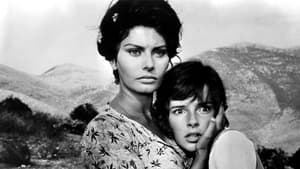Video Sources 0 Views
- Watch trailer
- Two Women 1960 Colorized


Synopsis
Table of Contents
Toggle
Step into war-torn Italy with Two Women, a powerful war drama from 1960, now beautifully colorized for a viewing experience that brings new life to this classic film. Directed by Vittorio De Sica and starring Sophia Loren and Jean-Paul Belmondo, this film tells a heartbreaking story of a mother’s determination to protect her daughter amidst the devastation of World War II. Perfect for fans of historical dramas and those who appreciate outstanding performances, this HD download offers a poignant and visually stunning journey into a dark chapter of history. Also known as La Ciociara, this restored version allows a new generation to experience its emotional depth.
Set during World War II, Two Women (La Ciociara) tells the story of Cesira (Sophia Loren), a widowed shopkeeper in Rome, and her young daughter, Rosetta (Eleonora Brown). Fearing for their safety amidst the escalating Allied bombings, Cesira decides to flee the city and return to her rural hometown of Ciociaria.
In Ciociaria, they seek refuge from the war, facing hunger, deprivation, and the constant threat of violence. Cesira attracts the attention of Michele (Jean-Paul Belmondo), a young intellectual with communist sympathies, who offers them help and companionship. Their lives take a devastating turn when, while attempting to return to Rome after the Allied capture, Cesira and Rosetta are brutally attacked. The film explores the aftermath of this trauma and the resilience of the human spirit as Cesira fights to help her daughter heal and rebuild their lives. Two Women is a gripping portrayal of survival, loss, and the enduring bond between a mother and daughter.
The film features remarkable performances from its cast:
-
Sophia Loren as Cesira
-
Jean-Paul Belmondo as Michele Di Libero
-
Eleonora Brown as Rosetta
-
Raf Vallone as Giovanni
Two Women is an Italian war drama that falls into the Italian Neorealism movement, known for its realistic portrayal of post-war life and its focus on social issues. The film combines elements of drama, history, and social commentary to create a moving and thought-provoking cinematic experience.
Released in 1960, Two Women is set against the backdrop of World War II, a period of immense suffering and upheaval in Italy. The film reflects the themes of Italian Neorealism, a cinematic movement that sought to depict the lives of ordinary people and the harsh realities of post-war Italy. Two Women is a powerful example of this genre, offering a raw and unflinching look at the impact of war on individuals and communities.
This colorized version of Two Women has been meticulously restored using modern digital techniques, enhancing the visual appeal while retaining the film’s original emotional power. The colorization process involved a careful analysis of the black and white footage, with colors chosen to reflect the historical accuracy and emotional tone of each scene. Advanced algorithms were used to ensure a seamless and natural-looking color palette, bringing new depth and vibrancy to the characters and settings. This restoration introduces this important film to a new audience, making it more accessible and engaging for contemporary viewers.
-
: Vittorio De Sica
-
: Cesare Zavattini, Vittorio De Sica, based on the novel by Alberto Moravia
-
: Gábor Pogány
-
: Adriana Novelli
-
: Société Générale de Cinématographie, Champion Film
-
: Titanus
-
: 102 minutes
-
: MP4
-
: HD (1080p)
-
: Compatible with most devices, including smartphones, tablets, computers, and smart TVs.
Two Women is widely regarded as a masterpiece of Italian cinema, earning Sophia Loren an Academy Award for Best Actress – the first Oscar ever given for a performance in a foreign-language film. The film has been praised for its powerful performances, its realistic portrayal of war, and its moving exploration of the mother-daughter relationship. Two Women remains a significant and influential work, continuing to resonate with audiences today.
-
: What is Two Women about?
-
A: Two Women is a war drama about a mother and daughter struggling to survive in Italy during World War II.
-
-
: Is Two Women (1960) a well-known Italian film?
-
A: Yes, Two Women is considered a classic of Italian cinema, known for its powerful story and Sophia Loren’s Oscar-winning performance.
-
-
: Is this version of Two Women colorized?
-
A: Yes, this version has been professionally colorized to enhance the viewing experience.
-
-
: What makes Two Women interesting for film enthusiasts?
-
A: Two Women is a significant example of Italian Neorealism, offering a realistic and moving portrayal of war and its impact on ordinary people.
-
-
: What is the download format?
-
A: The download format is MP4, which is compatible with most devices.
-
-
: What resolution is the download?
-
A: The resolution is HD (1080p), providing a high-quality viewing experience.
-
Watch Two Women Today!
















